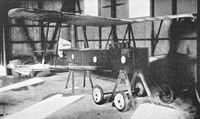
Описание
Страна: Великобритания
Год: 1917
H.King Sopwith Aircraft 1912-1920 (Putnam)
A.T. and Sparrow
The wireless control of aircraft, boats, torpedoes and fighting vehicles was a topic which, by 1918, had engaged the attention of many inventors for several years. By early 1919, indeed, one authority gave this reminder: 'Experiments upon the wireless control of self-propelled bodies such as boats, torpedoes and airships have been in progress in various countries during the past twenty years, and when the war broke out some considerable success had been achieved with models, and in some cases with craft too large to be called models. In America Tesla and Edison were early workers in this field, the former in 1897 having succeeded in devising a small model boat which could, it is said, be made to follow a short prescribed course by the action of Hertzian waves. Hammond, also in America, although he met with much to discourage him at first, carried his investigations and experiments so far that by 1912 he was able to claim that he could control a 25-knot motor launch with precision over a range of three miles or so. In Germany the most noteworthy results were those obtained by Wirth, of Nuremberg, who, round about 1911, exhibited a 50 ft. motor boat which was under radio-dynamic control and which could be made at will to discharge guns, lights and fireworks. In France Deveaux, in 1906, demonstrated to the French naval authorities the working of a wirelessly [sic] directed boat carrying an 18 in. Whitehead torpedo in an ejecting tube. In Gt. Britain Gardner constructed and successfully tested a fair-sized craft of a similar nature, while Roberts, an Australian, in 1912 exhibited an airship about 20 ft. long which flew under wireless control round lecture halls and theatres. In all these prewar instances the distance over which the control could be exercised was short, varying from a few yards to a few miles. Taking account of the developments which other branches of wireless communication have recently undergone there is, however, no difficulty in believing that means are now available for extending the control over ranges of a hundred miles and upwards.'
The possibilities of jamming were mentioned by the same authority in the context of 'a method of neutralising signals coming from any particular direction' which had been used 'during the last days of the war to prevent the Germans at the Nanen station from "jamming" messages passing between Allied wireless stations.' Thus (it was added): 'The dependence of the ground-controlled aeroplane or torpedo upon a system of wireless communication which it is within the power of someone else besides the operator to transmit, and the possibility of that someone issuing contrary commands or nullifying those sent out by the operator, have long presented one of the chief problems to the inventors of wirelessly directed bodies. Many attempts have been made to devise means which would render interference impossible, but very little success attended these efforts ... It would seem that for military purposes the high-flying wirelessly controlled aeroplane or airship provided with an automatic course recorder enabling its position to be laid down from instant to instant on a map at the control station is the only development of this latest aeronautical application which is likely to prove of military value.'
At the time of the foregoing - historically relevant if not, perhaps, scrupulously accurate - pronouncement (early 1919) nothing could be said of the work which had been pressed forward by Capt Archibald M. Low, RFC, (better known as Prof A. M. Low) at Brooklands, Feltham and Farnborough; this despite the fact that Capt Low had applied for a patent on 9 January, 1918, which patent was accepted on 10 December of that same year, though publication was witheld until late in 1925. Nevertheless, even during the preceding year (1924) Prof Low whose work on radio control had begun in 1916 - was looking yet further ahead, for as he himself then declared:
'The pilot of an aeroplane can talk to his base; he will soon be able to write and transmit vision from a plane which could be controlled by wireless. The time will come when low-flying wireless planes will explore, and render visible at many miles distant, places where no human pilot could remain for any length of time in safety.'
These preceding declarations have been set out here to emphasise that during 1914-18 radio control was not a complete novelty; that the British authorities were by no means as backward or as stupid with regard to this technique as might be supposed; that Capt Low was encouraged in and by his work; and that the radio control of motor boats (a form of craft in which T. O. M. Sopwith took a personal interest) was very much in mind-special 'floats' or 'sea-sleds' having been proposed.
One must now proceed to show how Sopwith's involvement extended to the aircraft side, and how the A.B.C. engine company contributed to Britain's programme with a series of horizontally opposed two-cylinder air-cooled units, latterly, at least, given the name Gnat.
To conceal the true purpose (bombing, or possibly the attack of airships) of several small pilotless radio-controlled aircraft made (or intended to be made) by the Royal Aircraft Factory and the de Havilland (Airco) and Sopwith concerns, the cover-name 'Aerial Target' (A.T.) was adopted; and to stress that Britain's programme of the First World War was not the mere superficial - even light-hearted - affair that it has sometimes been made out to have been, one would add that on the engine-development side not A.B.C alone, but Armstrong Siddeley also, with their tiny Ounce, were active into the 1920s. (Later still the Armstrong Siddeley Lynx engine gave a name to the Larynx flying-bomb developed by the Royal Aircraft Establishment).
Sopwith's first contribution to the 'A.T.' programme was never flown, apparently because of damage to the bottom starboard wing and upper port wing, sustained during erection at Feltham. An existing photograph shows this damage and two other features of special interest: first, the sharp dihedral angle for lateral stability; second, the four-wheel landing gear. Both these features, of course, might naturally be expected on an experimental flying-bomb or aerial target (now using the latter term in its 'open' sense), though one is nevertheless tempted to relate them - with the utmost circumspection - to the following facts:
By early 1918 tests had been undertaken in the William Froude National Tank at Teddington to find a 'suitable float for an aerial target'; so, while giving due observance to 'National', it is also permissible to note that Teddington was almost literally 'next door’ to Feltham (as well as Sopwith's Kingston works) and thus to suggest that the tests may have been related to a known request by the Royal Navy for an air-launched 'glider target’. To minimise damage on striking the sea this was designed as a floatplane, was made longitudinally stable, and was steered by obsolete spring-driven torpedo gyroscopes.
Clearly, the Sopwith A.T., with its massive four-wheel landing gear might fairly readily have been adapted as a floatplane and used either as a glider target or as a wireless-controlled pilotless aircraft or flying-bomb.
Conjecture aside, the Sopwith A.T. had a rudimentary structure, respecting both the square-section fuselage and the single-bay wings - these last having very few ribs and being attached to inverted-V struts on the centre-line. For wireless control, the aerials were wound round the rear part of the fuselage and the outboard sections of the upper wings. Light-painted discs on the fuselage might be associated with tracking - possibly photographic.
The Sopwith Sparrow - for such was the undoubted name of the A.T.'s successor was greatly refined in design, and quite clearly related to the SL.T.BP. Certainly it had a cockpit for a pilot (as had the comparable de Havilland Queen Bee of later years) and it was somewhat larger than the earlier A.T., the span apparently being just over 25 ft (7.6 m). The refinement mentioned largely concerned the nose, which was aerodynamically cleaner than that of other A.B.C.-powered Sopwith types (the Rainbow racer included) - largely by reason of the fact that the 35 hp Gnat engine had two cylinders only, and these horizontally opposed. The Sparrow differed also from the original A.T. in having a conventional centre-section, with trailing-edge cut-out; and lateral control was positively by wing-warping, whereas the A.T. seems to have lacked even this 'refinement', being dependent for lateral stability on its sharp dihedral angle. Vastly different also was the clean, typically Sopwith, V-strut landing gear.
These points notwithstanding, if the Sparrow airframe underwent appreciable development at all, then this was not in the direction of a wireless-controlled flying-bomb, the design possibly having been superseded by the Ounce-engined monoplane designed at the Royal Aircraft Establishment, Farnborough a design which itself had a precursor in the 50 hp Gnome-engined RFC Experimental Works 'A.T.' That the 50 hp Gnome was apparently the designated powerplant for four 'Sopwith small scouts' with warping wings, which aircraft were seemingly at Brooklands in May 1917, may well have signified some association with the Bee (see earlier) rather than with the British 'A.T.' project - wherein, as shown, Sopwith nevertheless played their part. Certainly the Sparrow appears to have dated from a later period.
As for the little A.B.C engine which represented such an important element in the 'A.T.' project, and for which a power of 35 hp has already been mentioned (this figure evidently being a maximum-output, of course, depending much upon tuning, life expectancy and state of development) it may be noted in this regard that during 1917 a small Lang propeller was designed 'primarily for use' (as it was later stated) 'on an A.B.C. Gnat engine of 28-30 hp, mounted in an R.E. [sic] experimental machine for control by wireless waves.' It was added: 'This same design of airscrew was used for the small "Kitten" type aeroplanes, designed at Eastchurch Air Station and the Isle of Grain Experimental Station during 1917.' (The Lang propeller works, it may be noted, were at Weybridge, near Brooklands). Thus, in the matter of powerplant, as well as in other connections, Sopwith may have had some particular association with the Eastchurch Kitten.
Описание:
- H.King Sopwith Aircraft 1912-1920 (Putnam)
- J.Bruce British Aeroplanes 1914-1918 (Putnam)
Фотографии
-
J.Bruce - British Aeroplanes 1914-1918 /Putnam/
Sopwith Sparrow.
-
H.King - Sopwith Aircraft 1912-1920 /Putnam/
Evidently descended from the SL.T.B.P., the diminutive Sopwith Sparrow of late 1917 used a 35hp ABC Gnat flat-twin (or horizontally opposed) and was built for work into radio-controlled aircraft being done by Capt A.M. Low, RFC. Although a number of parallel studies were being carried out at this time into the use of radio-controlled, explosive-filled aircraft as guided missiles, the minimally sized and powered Sparrow was more probably aimed at providing one of the world's first evasive aerial targets.
-
J.Bruce - British Aeroplanes 1914-1918 /Putnam/
Sopwith A.T.



